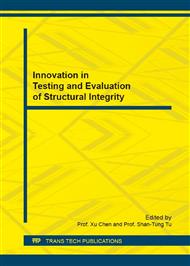[1]
H. Altenbach, K. Naumenko, Y. Gorash, Creep analysis for a wide stress range based on stress relaxation experiments, Int. J. Mod. Phys. B, 22 (2008) 5413-5418.
DOI: 10.1142/s0217979208050589
Google Scholar
[2]
J.A. Daleo, K.A. Ellison, D.A. Woodford, Application of stress relaxation testing in metallurgical life assessment evaluations of GTD111 alloy turbine buckets, J. Eng. Gas Turb. Power, 121 (1999) 129-137.
DOI: 10.1115/1.2816299
Google Scholar
[3]
T. Ohba, O. Kanemaru, K. Yagi, C. Tanaka, Long-term stress relaxation properties of NCF 800H alloy, J. Soc. Mater. Sci. (Japan), 46 (1997) 19-24.
DOI: 10.2472/jsms.46.3appendix_10
Google Scholar
[4]
F.V. Ellis, S. Tordonato, Calculation of stress relaxation properties for type 422 stainless steel. J. Press. Vess. -T. ASME, 122 (2000) 66-71.
DOI: 10.1115/1.556152
Google Scholar
[5]
D.A. Woodford, Advances in the use of stress relaxation data for design and life assessment in combustion turbines, JSME Int. J. A-Solid M. 45 (2002) 98-103.
DOI: 10.1299/jsmea.45.98
Google Scholar
[6]
C.G. Ek, B. Hagström, J. kubát, M. rigdahl, Prediction of the creep behavior of polyethylene and molybdenum form stress relaxation experiments, Rheol. Acta, 25 (1986) 534-541.
DOI: 10.1007/bf01774405
Google Scholar
[7]
J.H. Kim, T.S. Byun, D.T. Hoelzer, Stress relaxation behavior of nanocluster-strengthened ferritic alloy at high temperatures, J. Nucl. Mater. 425 (2012) 147-55.
DOI: 10.1016/j.jnucmat.2011.06.040
Google Scholar
[8]
P. Spatig, J. Bonneville, J.L. Martin, A new method for activation volume measurements-application to Ni3(AL, HF), Mat. Sci. Eng. A-Struct. 167 (1993) 73-79.
DOI: 10.1016/0921-5093(93)90339-g
Google Scholar
[9]
G.A. Sargent, H. Conrad, Stress relaxation and thermally activated deformation in a titanium-4wt percent aluminum alloy, Scripta Metall. 4 (1970) 129-133.
DOI: 10.1016/0036-9748(70)90178-x
Google Scholar
[10]
A.G. Evans, R.D. Rawlings, Thermally activated deformation of crystalline materials, Phys. Status Solidi B. 34 (1969) 9-31.
DOI: 10.1002/pssb.19690340102
Google Scholar
[11]
S. Wang, N. Hashimoto, Y.M. Wang, S. Ohnuki, Activation volume and density of mobile dislocations in hydrogen-charged iron, Acta Mater. 61 (2013) 4734-4742.
DOI: 10.1016/j.actamat.2013.05.007
Google Scholar
[12]
V.I. Dotsenko, Stress relaxation in crystals, Phys. Status Solidi B. 93 (1979) 11-43.
Google Scholar
[13]
National Research Institute for Metals, NRIM Creep Data Sheet No. 44, National Research Institute for Metals, Tokyo, (1997).
Google Scholar
[14]
D. Caillard, J.L. Martin, Thermal activation mechanisms in crystal plasticity, Pergamon, Amsterdam, (2003).
Google Scholar
[15]
L. Lu, T. Zhu, Y.F. Shen, M. Dao, K. Lu, S. Suresh, Stress relaxation and the structure size-dependence of plastic deformation in nanotwinned copper, Acta Mater. 57 (2009) 5165-5173.
DOI: 10.1016/j.actamat.2009.07.018
Google Scholar
[16]
B.H. Zhang, Calculation of self-diffusion coefficients in iron, AIP Adv. 4 (2014) 017128-1-017128-6.
Google Scholar


